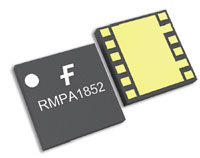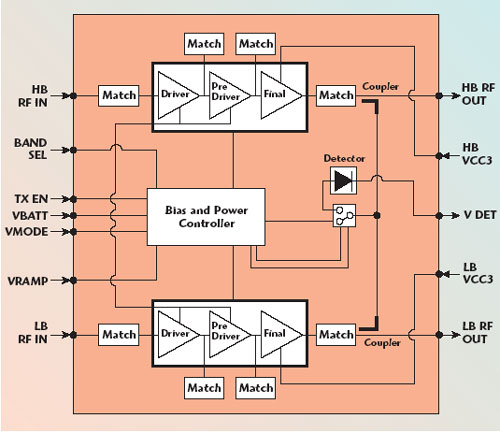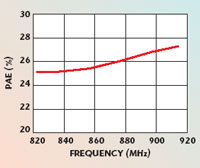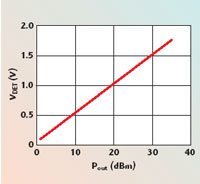
A new quad-band/dual-band power amplifier (PA) module has been developed for use with dual-mode GSM and EDGE handsets. The RMPA1852 PA module was designed to deliver the highest power efficiency in EDGE mode without sacrificing performance in GSM mode. The product achieves 27 percent power-added efficiency (PAE) in EDGE applications and 55 percent PAE in GSM mode.
The new PA module includes closed-loop power control circuitry for GSM applications and an open-loop power control circuit for EDGE applications. A mode select switch is utilized to select between GSM/EDGE modes. The module offers linear power control in both modes of operation that helps to minimize phone calibration time during handset production and test. The dual-mode configuration helps to minimize the required external components and maximize board yields. Figure 1 shows the device’s functional block diagram. This module also supports a high/low output power feature in EDGE mode to minimize current consumption in low power operation.
The RMPA1852 PAM is designed to operate from a +3.5 V DC supply and contains an integrated voltage regulator. It features an internal shutdown/standby capability for efficient battery operation and is housed in a 7.0 × 7.0 × 1.3 mm surface-mount package.
Performance Specifications

Fig. 1 Functional block diagram for RMPA1852.
The device’s dual-mode performance is broken down into essentially four separate frequency ranges. Within the 824 to 849 MHz region for CEL Tx-band operation the unit features a typical output power in GMSK mode of 35 dBm with an input power of 3 dBm. PAE is 55 percent and the power control range is 40 dB for a Vramp of 0.2 to 1.8 V, as shown in Figure 2. Within the same frequency range the EDGE mode typical output power is 29.0 dBm with a PAE of 27 percent. Figure 3 shows the EDGE mode PAE performance.

Fig. 2 Pout vs.Vramp in GSM mode.

Fig. 3 EDGE mode PAE at Pout = 29 dBm, Pin = 12 dBm, Vcc = 3.5 V and Vset = 3.3 V.
In the 880 to 915 EGSM Tx-band the GMSK typical output power is again 35 dBm with a PAE of 55 percent.For the GSM900 Tx-band in EDGE mode the typical output power is 29.0 dBm at 27 percent PAE.
In the 1710 to 1785 MHz DCS Tx-band region in GMSK mode the PAM’s typical output power is 33 dBm with +3 dBm input with a PAE of 50 percent. Again, the power control is 40 dB for the same control voltage as before. In the DCS Tx-band in EDGE mode the typical power output is 28 dBm and PAE is 26 percent.
Finally, in the 1850 to 1910 MHz operating range the GMSK mode typical output power for the PCS Tx-band is 33 dBm and PAE is 50 percent. The power control remains unchanged. For EDGE operation in the same range the typical output power is 28 dBm with a PAE of 26 percent.
There is a power detector in EDGE mode that supplies an output voltage vs. power output to an external pin. Its detector voltage vs. EDGE output power characteristic is shown in Figure 4.

Fig. 4 Detector voltage vs. power output in EDGE mode.
Absolute maximum ratings include a maximum supply voltage of 6 V and maximum input power of 12 dBm. Its operating temperature is –30° to +85°C and maximum junction temperature is 150°C.
Conclusion
A quad-band GSM/EDGE PA module has been described that is designed for 2.75G radio applications that features GSM integrated power control and a mode select switch for selection of power control modes. The PA module features 50 W inputs and outputs, and shutdown/standby capability for battery operation. More information may be obtained from the company’s Web site. Samples are currently available.
Fairchild Semiconductor Corp.,
Tyngsboro, MA
(978) 226-2000,
www.fairchildsemi.com
